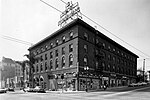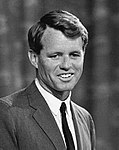Wilshire/Normandie station
1996 establishments in CaliforniaD Line (Los Angeles Metro)Koreatown, Los AngelesLos Angeles Metro Rail stationsRailway stations in the United States opened in 1996 ... and 3 more
Railway stations located underground in CaliforniaWilshire, Los AngelesWilshire Boulevard

Wilshire/Normandie station is an underground rapid transit (known locally as a subway) station on the D Line of the Los Angeles Metro Rail system. It is located under Wilshire Boulevard at Normandie Avenue, after which the station is named, in the Mid-Wilshire and Koreatown districts of Los Angeles. Wilshire/Normandie is one of only two D Line stations not shared with the B Line.
Excerpt from the Wikipedia article Wilshire/Normandie station (License: CC BY-SA 3.0, Authors, Images).Wilshire/Normandie station
Wilshire Boulevard, Los Angeles Koreatown
Geographical coordinates (GPS) Address Nearby Places Show on map
Geographical coordinates (GPS)
| Latitude | Longitude |
|---|---|
| N 34.0618 ° | E -118.3002 ° |
Address
Wilshire & Normandie
Wilshire Boulevard
90005 Los Angeles, Koreatown
California, United States
Open on Google Maps






